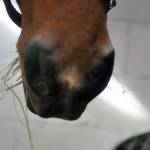Role of Fungi in Equine Respiratory Disease

Horses that spend the majority of their time inside are exposed to high levels of aerosolized particles, putting them at risk for respiratory troubles down the road. Stabling may spell double trouble for horses already dealing with breathing issues.
“The effects of chronic respiratory disease vary from horse to horse, but few horses can perform their best when troubled with breathing issues,” said Laura Petroski-Rose, B.V.M.S., staff veterinarian for Kentucky Equine Research. “Organic dust, such as bacteria and fungi, often incite respiratory distress in susceptible horses, especially those that are stabled.”
Because fungal spores and fragments are minute, they easily become lodged deep into the airways during inhalation. For most horses, the fungi cause no harm. For horses with recurrent airway obstruction (RAO), however, fungi can trigger an inflammatory response. Researchers recently set out to determine if fungi had a similar effect on horses with inflammatory airway disease (IAD), a respiratory condition less severe than RAO.
A team of Belgian researchers evaluated the presence of fungi in respiratory samples collected from healthy horses and horses with IAD; described clinical signs linked to the presence of fungi in horses diagnosed with IAD; and determined the risk factors associated with IAD in the presence of fungi.
For this study, the researchers used a mixture of sport and leisure horses, all of which were examined by veterinarians for respiratory disease, suboptimal performance, or for routine health maintenance. All 731 horses underwent a physical examination, airway endoscopy, tracheal wash, and bronchoalveolar lavage. Management data were also collected, including type of forage fed and how the forage was treated before feeding (moistened or steamed, for example), as well as type of bedding used.
Of the 731 horses, 55% had positive fungal cultures. Those horses with fungi in their tracheal wash had two times greater likelihood of having IAD than horses with no detectable fungi. According to the researchers, “the risks of being diagnosed with IAD and the likelihood of fungi in the tracheal wash were higher when horses were bedded on straw or fed dry hay.”
Researchers concluded horses that inhale fungal particles are much more likely to develop IAD than those that are not exposed. As reported in earlier studies, certain forages and bedding materials increase the risk of IAD.
Careful management decisions can help stave off acute episodes of respiratory distress in horses that have been diagnosed with RAO and IAD. “One nutritional strategy often implemented is the use of omega-3 fatty acids, particularly DHA and EPA,” said Catherine Whitehouse, M.S., a nutrition advisor at Kentucky Equine Research. “More and more, horse owners and veterinarians are observing the advantages of adding fish oil in the diets of respiratory-compromised horses.”
Fish oils are direct sources of DHA and EPA. EO-3, a marine-derived source of DHA and EPA developed by Kentucky Equine Research, confers several health benefits to horses, including anti-inflammatory properties that often help horses with respiratory problems.
*Dauvillier, J., F. ter Woort, and E. van Erck-Westergen. 2018. Fungi in respiratory samples of horses with inflammatory airway disease. Journal of Veterinary Internal Medicine.








